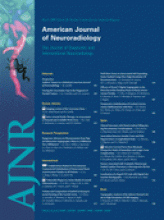I have read with interest the article by Tosaka et al in the June-July 2008 issue of the American Journal of Neuroradiology.1 The authors describe with exquisite detail the characteristics of dural and subdural fluid in spontaneous intracranial hypotension. They have recognized and collected cases describing a new sign of lineal dural hyperintensity. As they stated in their article, “Dural hyperintensity on FLAIR was present, but not described in some intracranial hypotension articles” that they reviewed.
The greatest advantage of fluid-attenuated inversion recovery (FLAIR) sequences compared with T2-weighted sequences has been the separation of hyperintense lesions from fluid (CSF in ventricles or subarachnoid space). This results in superior lesion detection and conspicuity. Since the introduction of FLAIR in 1990 and the progressive validation of its use in different clinical situations, it has been included in all brain MR imaging protocols at least in 1 plane.
The authors compared the hyperintensity in FLAIR with the enhancement of the dura in extent, distribution, and location, finding a high correlation between them, and they also showed how the hyperintensities improve or disappear in the follow-up studies. They noticed a different pattern of response to the treatment of FLAIR hyperintensity and dural enhancement on one side compared with subdural effusions on the other.
I can foresee that because FLAIR sequences are not routinely performed in the spine, dural hyperintensity on FLAIR images has not yet been described, but most likely the same hyperintensity will soon be noted.
In our article from 2000, “Spontaneous Intracranial Hypotension: Use of Unenhanced MRI,”2 the T2 hyperintensity mainly corresponded to the FLAIR hyperintensity. Unfortunately at that time, FLAIR was a long sequence not validated for many uses, which I used only for patients with multiple sclerosis. The article of Tosaka et al1 supports the observation we made in 2000 (ie, contrast is not necessary for the diagnosis of spontaneous intracranial hypotension syndrome).
The syndrome of spontaneous intracranial hypotension has also evolved with time. The clinical symptoms have been known for decades, but the MR imaging signs have progressively become more numerous as MR imaging has become widely available and as scanners and sequences have improved. Lumbar puncture is not always used to confirm the low CSF pressure because it may worsen symptoms. Patients may undergo MR imaging brain and spine studies without and with contrast, whole-spine imaging searching for dural tears, and all types of intrathecal injections (isotopic, iodinated, or gadolinium-based). These examinations are expensive, time-consuming, and uncomfortable for the patient. The number and combination of imaging studies performed for each patient can be enormous. The search for the dural-site tear should be left for patients who do not respond well to initial treatment and should be oriented to guide invasive therapeutic options such as epidural blood patch or saline infusions. The judicious use of imaging studies in the diagnosis and follow-up of these patients may have huge economic impact.
In my experience reading MR imaging scans and training residents, I often find “signs” that come into use while others fall out of use. Contrast enhancement of the dura was the hallmark of the syndrome in the 1990s, and some neurologists demand it. However, in fact, the enhancement is nonspecific and is present in other dural processes (ie, infectious and noninfectious granulomatous disease, neurosarcoidosis, etc) and does not help in the diagnosis of the syndrome.
After the article by Tosaka et al1 and our experience, I propose that the sign of dural FLAIR hyperintensity on nonenhanced brain MR imaging in the proper clinical setting, accompanied by other signs of dural or venous sinus engorgement, brain sagging, or subdural effusions, is sufficient to diagnose the syndrome of intracranial hypotension noninvasively.
References
- Copyright © American Society of Neuroradiology












